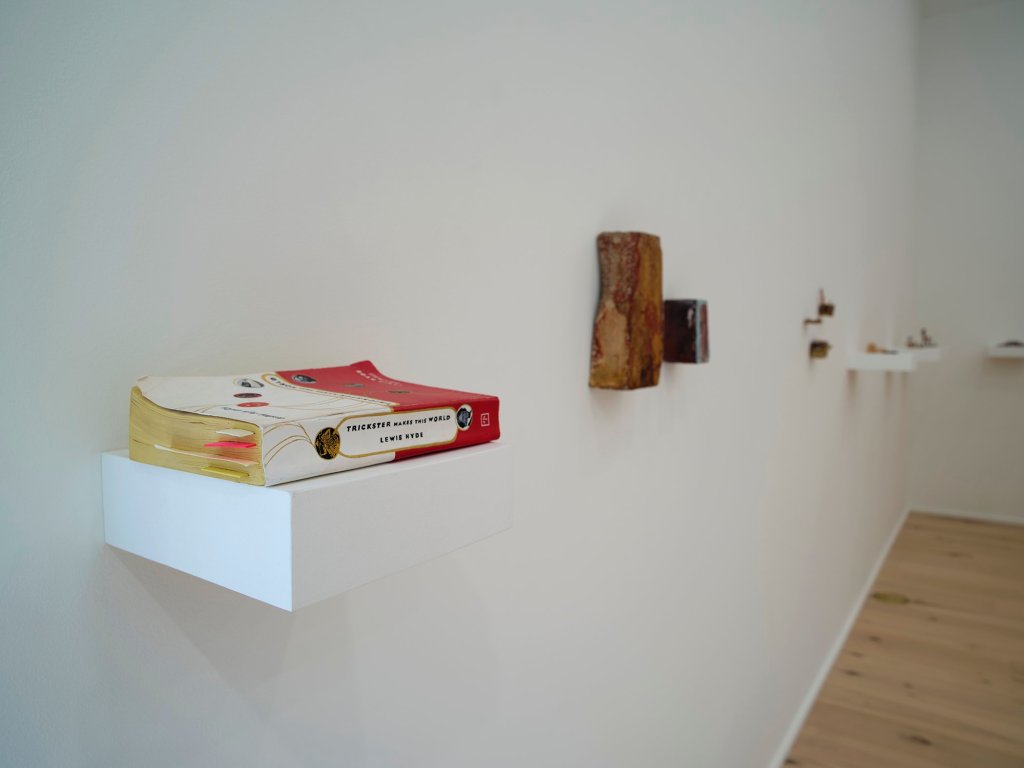
Gonna get a little higher
See if I can hot-wire reality
— Jackson Browne
Contributed by Mark Wethli / On a small shelf in a quiet corner of Sarah Bouchard Gallery in Woolwich, Maine, sits a dog-eared paperback copy of Lewis Hyde’s Trickster Makes This World: Mischief, Myth, and Art. With a growing sense of delight, we soon realize that the book is itself a trick, a trompe l’oeil sculpture by Justin Richel, convincing in every detail from its vintage 1990s graphics to its well-worn cover. Along one side of the book are four bookmarks, very likely denoting meaningful or inspiring passages. Everything about the piece suggests a volume that someone – presumably the artist – has re-read many times, determined to unlock its significance even as the object itself stands as proof of his success. It is a fitting overture to “You Don’t Know Me,” the four-person show currently on view. The artists – Carly Glovinski, Rachel Grobstein, Duncan Hewitt, and Richel – present kindred explorations of parallel realities, producing conundrums and contradictions that give rise to visual enchantment and philosophical contemplation.
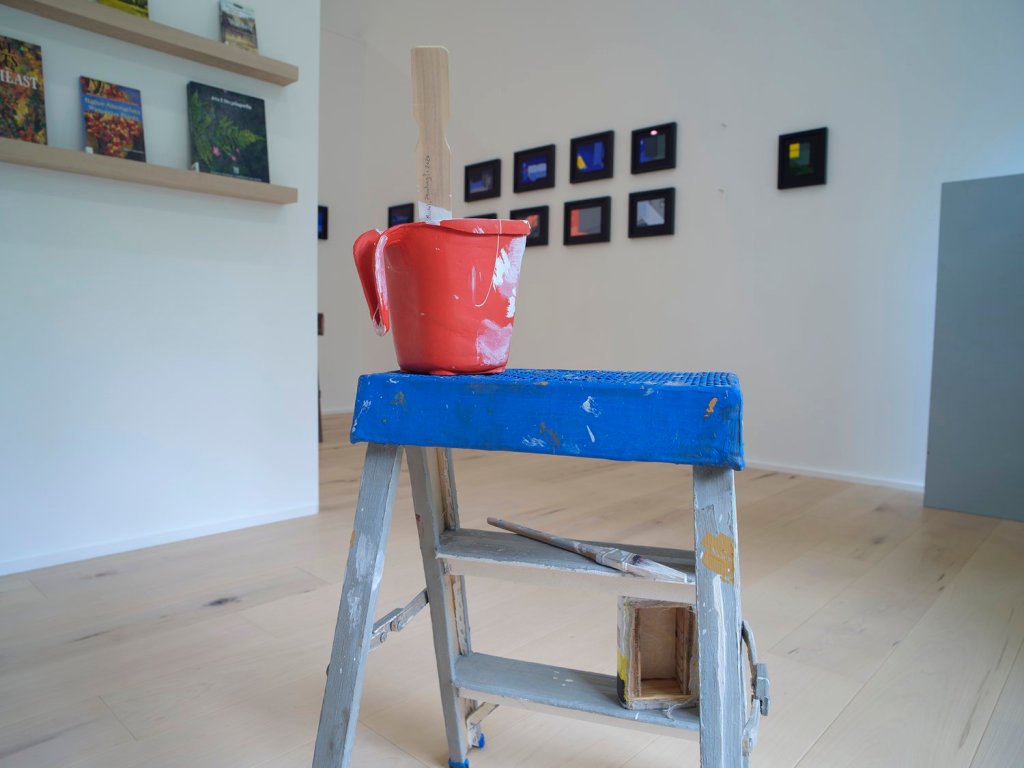
While each artist plays with our expectations, Richel’s work comes closest to the tradition of fooling the eye. Ever since the famed contest between the fifth-century BCE painter Zeuxis, whose painting of grapes deceived the birds into pecking at them, and his rival Parrhasius, whose painted drapery fooled even Zeuxis into trying to pull it aside, trompe l’oeil painting has embodied one of painting’s penultimate, if philosophically suspect, ambitions: to convince viewers that what they’re seeing is the thing itself. Running counter to the modernist mandate of faithfulness to materials and process, it’s an approach rarely practiced today, perhaps also due to the extraordinary skill, patience, and dedication it requires.
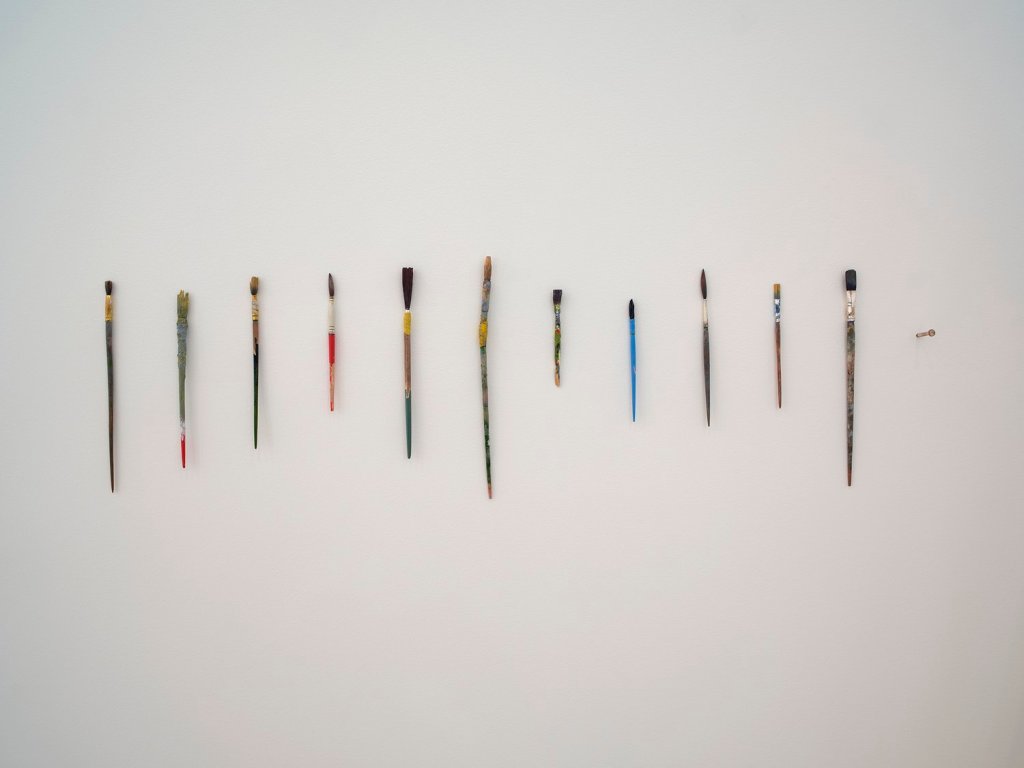
Richel’s gouache paintings, also in the show, could pass for cells in an early Disney animation, but one directed by Alfred Hitchcock or David Lynch. Their cool, orderly, and idealized views of domestic spaces are unsettling, imparting a quiet sense of foreboding about what’s behind that door, out that window, or at the top of those stairs. Richel’s illusionistic pieces – three dimensional but still paintings – provide all the phantasmagorical wonder one could hope for, with wood, canvas, and paint passing for wood of other kinds, aluminum, and plastic. Splatter and accidental markings achieve astonishing verisimilitude, chance effects being more challenging to reproduce than intentional ones. Atypically, Richel reveals his sleight of hand by exposing the back of the stretcher – usually hidden by a wall – to confirm their identity as paintings. This discovery, as surprising in its own way as the illusionism on the public-facing side of the work, not only demystifies the illusion but also creates a gratifying now-you-see-it-now-you-don’t frisson that elevates the illusionistic side of the piece still more. It also satisfies the modernist credo of making the artist’s process a part of the work. His corresponding focus on the artist’s tools, equipment, and materials echoes the philosophical “tools” we use to determine questions about what we know and how we know it, as well as Platonic queries about what constitutes an original. If reality can be replicated – hot-wired – can we trust the origins and identity of the world we think we know?
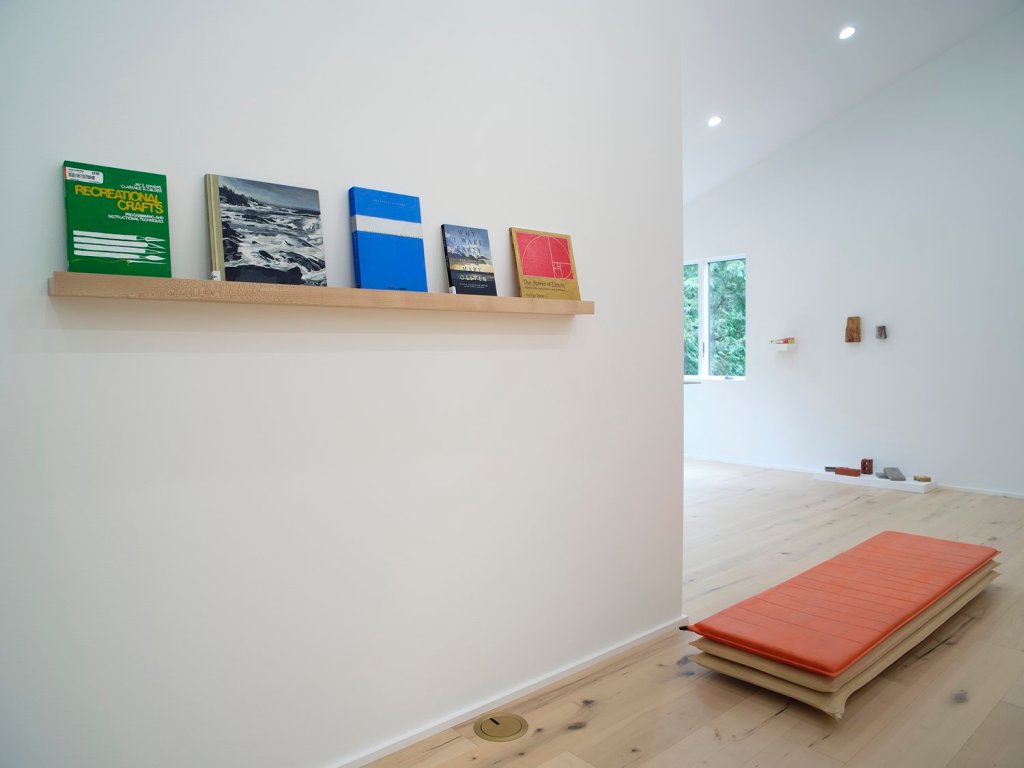
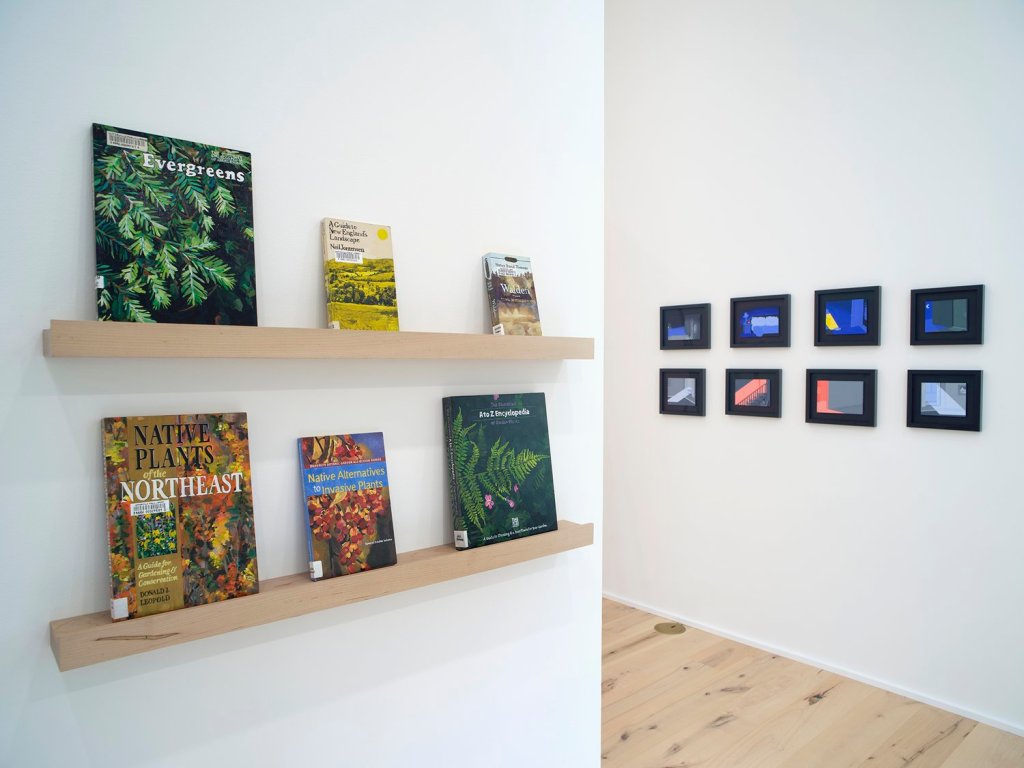
From ten feet away, Carly Glovinski’s assortment of trade books, displayed on a shelf, also look like the real thing. As we step closer, however, her proficient technique shifts our attention from that initial illusion to their quality as beautiful paintings. Capitalizing on the physical similarities between books and painting supports, they stand as seamless, mercurial transformations from one to the other. It’s an extremely satisfying effect, amplified by her permission to pick them up and examine them – access and intimacy that, in the customarily restrictive gallery context, is startling. Like her spectacular and well-received installation Almanac, currently on view at Mass MoCA, these works seem to emerge from a fascination with taxonomy as a means of focusing one’s attention. Her titles as well as her groupings invites speculation about the books’ themes and, even more, their provenance. They aren’t in mint condition but appear well cared for. One group, concerning natural subjects such as “Evergreens” or “Native Alternatives to Invasive Plants,” have the clear markings of library books, summoning books’ communal identity. The other, more heterogeneous group includes volumes that we might find on a friend’s coffee table or in a secondhand bookstore – a quiet monument to the lives of books as physical objects that suggests how much they’ve been loved and valued.
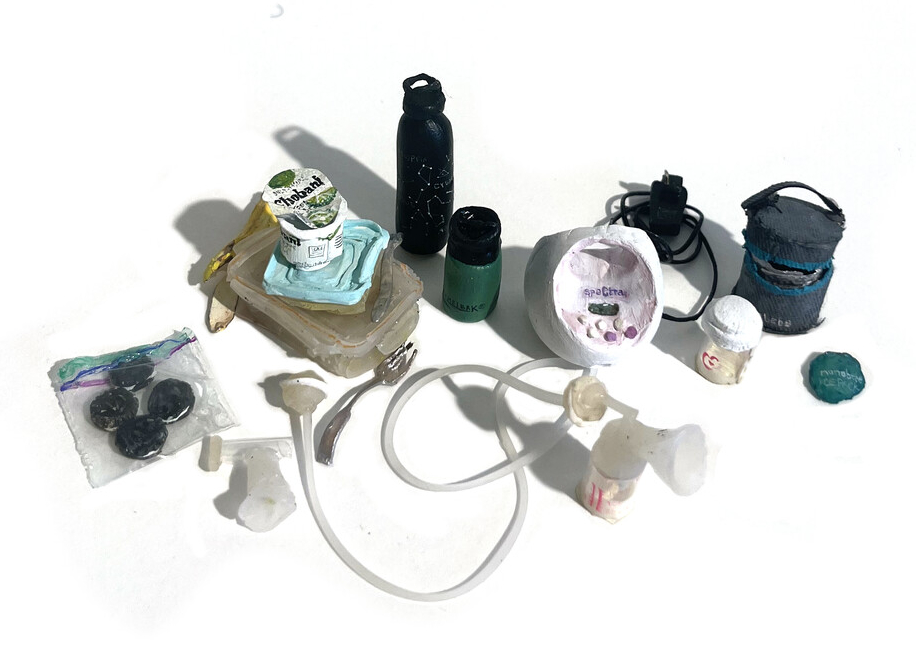
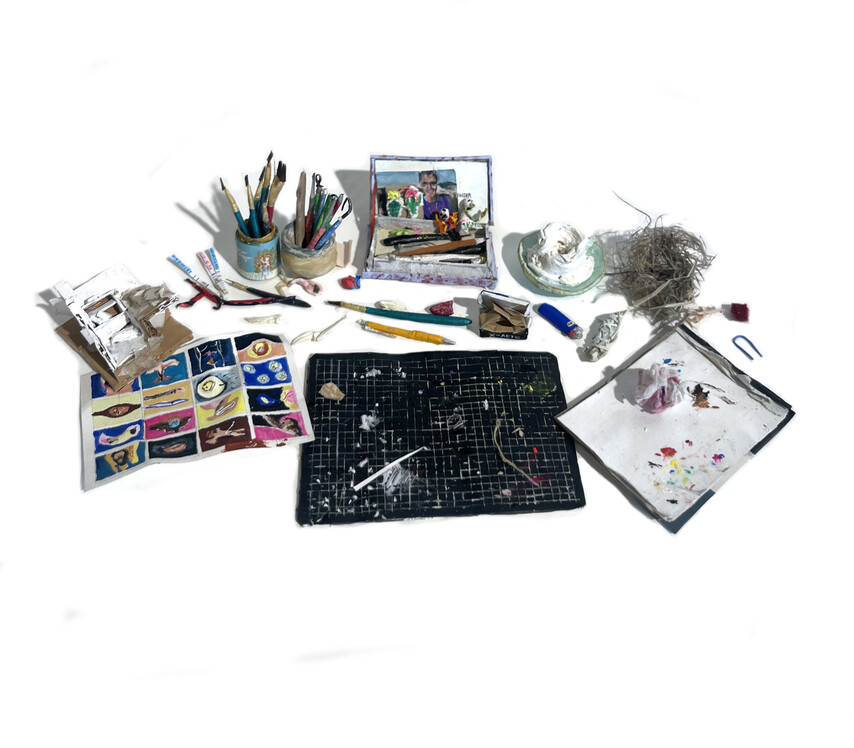
Rachel Grobstein’s tiny dioramas are the show’s most autobiographical and emotive works. Displayed just below eye-level on wall-mounted shelves, they offer an entrancing, Gulliver-like perspective on found still-life scenes, as if their occupant has just left the room. The objects are meticulously made, but not so much so that they foreclose an emotional connection to the artist. If they were life-sized, they would look more like Red Grooms than Jeff Koons. They reminded me of an experience I had many years ago at the Art Institute of Chicago. While museums often include full-scale period rooms, in this case they chose to present 68 miniature rooms created by Narcissa Niblack Thorne in the 1940s, featuring breathtakingly accurate depictions of interior designs from different periods in Europe, America, and Asia. While Grobstein forgoes that level of illusionism in favor of handmade objects, she too fits many tiny worlds in a single space. Somewhat paradoxically, their small scale, like that of the Art Institute’s rooms, makes the work especially memorable. In Studio (Miscarriage), less than seven inches wide, we see an artist’s tabletop workspace – palette, pens and brushes, X-Acto blades, and a cutting mat, among other items, as well as what might be reference material or works in progress. In time we discover a partially obscured snapshot of a male figure tucked into a pencil box, a sheet of paper with biological illustrations, a vacant workspace, and, most provocatively, an empty bird’s nest. The doubt and lament thus evoked cannot match those of a devastated family but opens these emotions to a shared understanding.
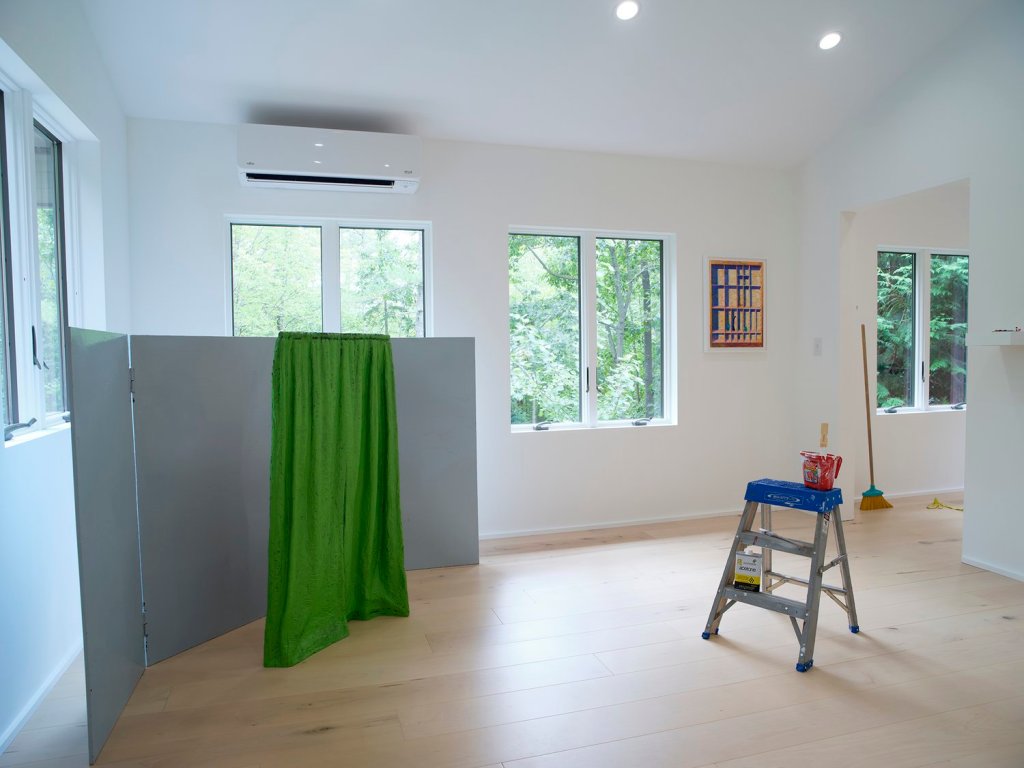
Duncan Hewitt, though a generation older than the other three artists, is no less youthful in his energy, wry humor, and edginess, and offers an extraordinarily nuanced and enigmatic selection. An admirer of his work for many years, including his solo show at the Portland Museum of Art in 2016, I’ve long appreciated its obtuse but thoroughly engaging character. Why are those life-size, finely detailed wooden carvings of inflatable sleeping pads stacked like that, and why is only the top one painted orange? Why do we feel such an uncanny sense of displacement when a block of wood has been sculpted into a representation of drapery, the chisel marks still visible and the voids nearly as palpable as the object? If Glovinski, Grobstein, and Richel each magnify personal experience, Hewitt, though no less autobiographical, is more cryptic. Thematically more than literally abstract, his work is closer in spirit to Joseph Beuys’ or Louise Bourgeois’ than, say, Martin Puryear’s. Two pieces depict drapes made to look as if they are hanging in midair like ghostly apparitions. They induce us to slow our pace and hold our breath, a phenomenological response that seems integral to the work. In Green Curtain (The Florian), we first see a “floating” carved wooden drape, painted green, in front of a battleship-grey metal folding screen. A slight gap between them invites us to look at the back, but the folding screen impedes our view. On the unpainted side is a framed photograph of a diaphanous cloth drape hanging in a workshop. Hewitt’s sculpture, it seems, is hiding a clue “behind its back.” Is it the model for the drape, the folding screen an abstraction of the woodshop? As with a Zen koan, we might never know the answer, but pursuing the question focuses the mind and prompts a poetic conception of the sublime.
The overlaps in the four artists’ work are numerous. The intersection in a Venn diagram of the show would include books, the artist’s studio, household objects, domestic life, autobiography, realism, illusionism, Platonism, tricksters, and trompe l’oeil, among other intersecting categories. A round of dialogues as much as four monologues, the show is truly a work in itself, rich in visual rewards as well as its uncommonly subtle, engaging, and invigorating achievements.
“You Don’t Know Me,” Sarah Bouchard Gallery, 13 Nequassset Pines Road, Woolwich, ME. Through November 23, 2024. Artists: Carly Glovinski, Rachel Grobstein, Duncan Hewitt, and Justin Richel.
About the author: Mark Wethli is a painter and the A. Leroy Greason Professor of Art Emeritus at Bowdoin College.
NOTE: We’re in the third week of the Two Coats of Paint 2024 Year-end Fundraising Campaign! This year, we’re aiming for full participation from our readers and gallery friends. Your support means everything to us, and any contribution—big or small—will help keep the project thriving into 2025. Plus, it’s tax-deductible! Thank you for being such a vital part of our community and keeping the conversation alive. Click here to contribute.

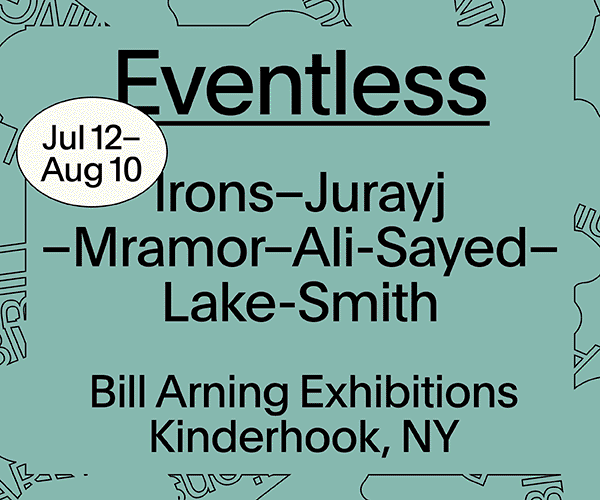
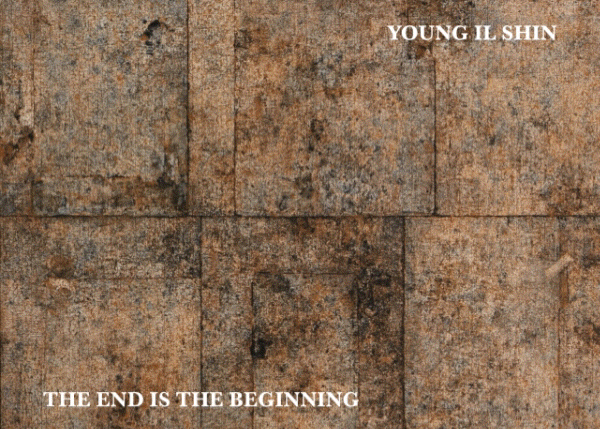
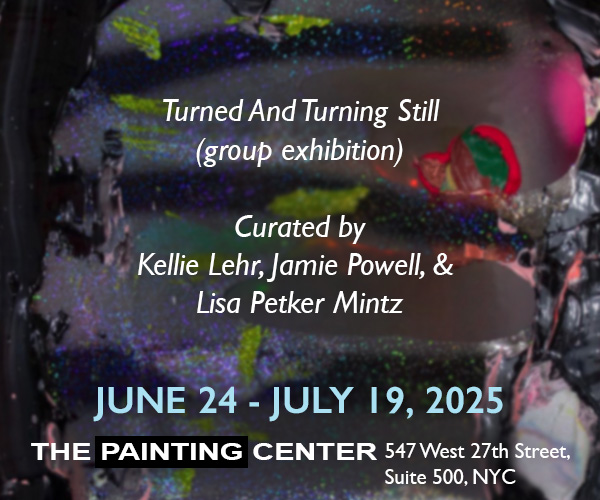
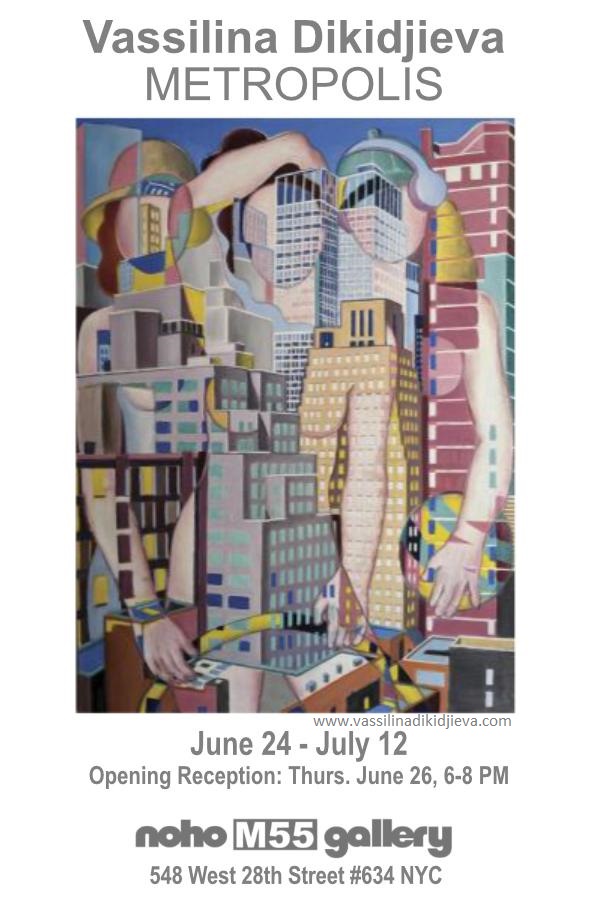
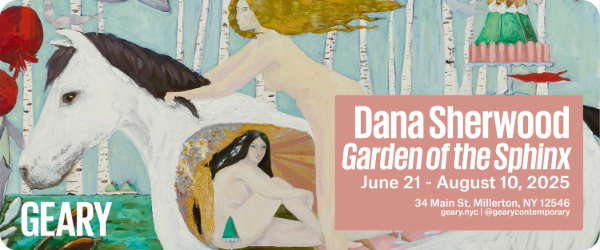










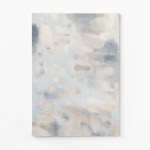
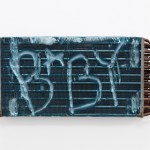
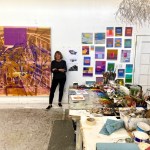
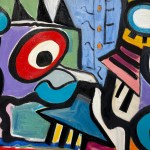
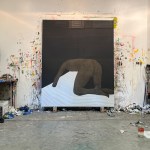
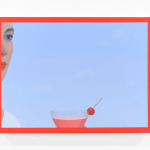
Wonderfully delightful and contemplative review Mark!! Not familiar with any of their works so thank you for your review and introduction.